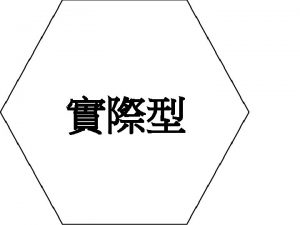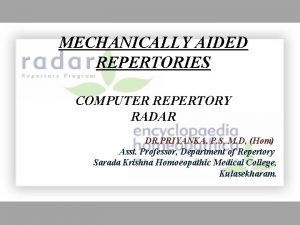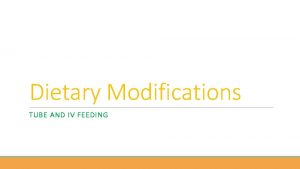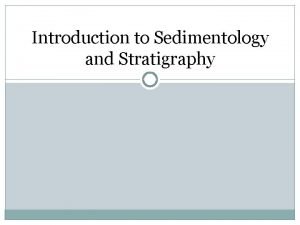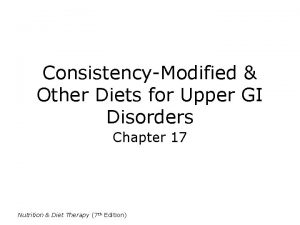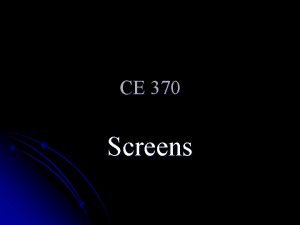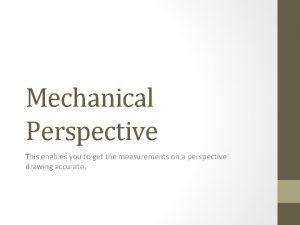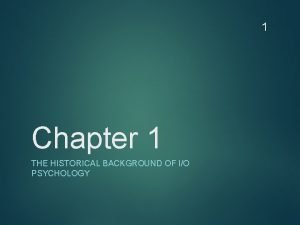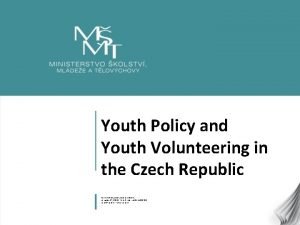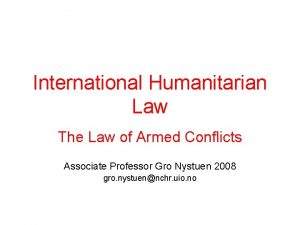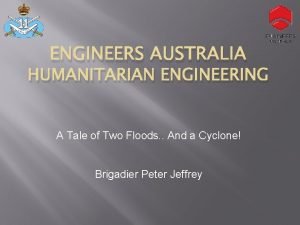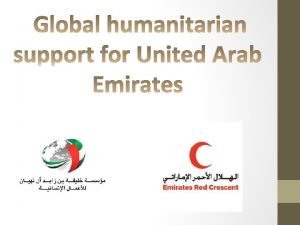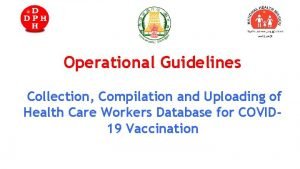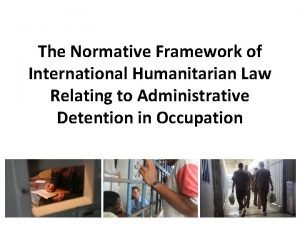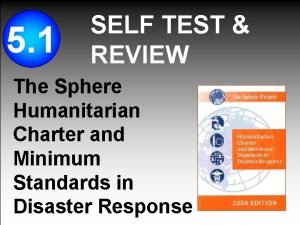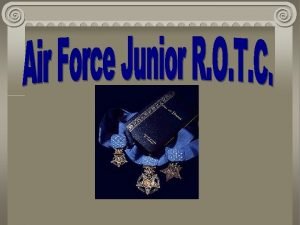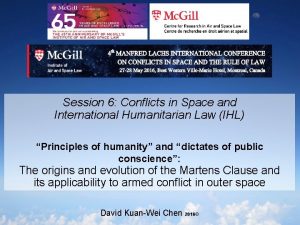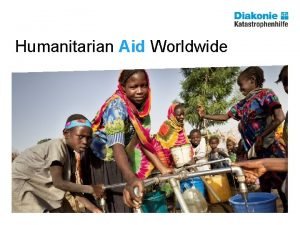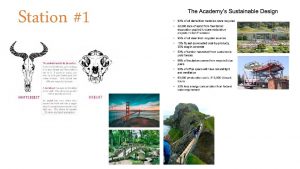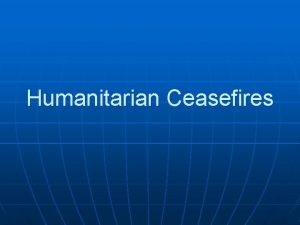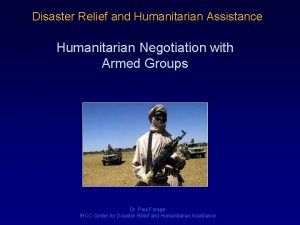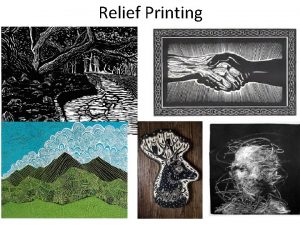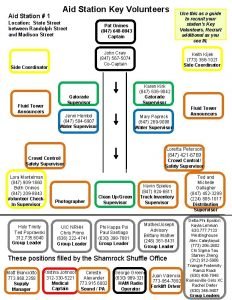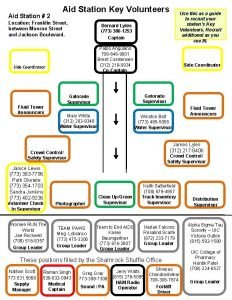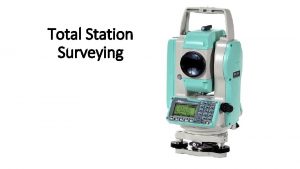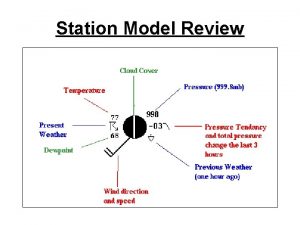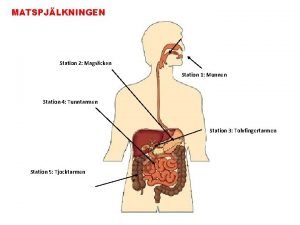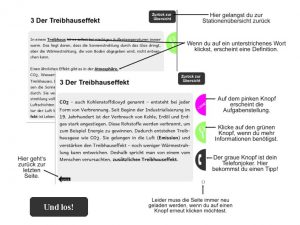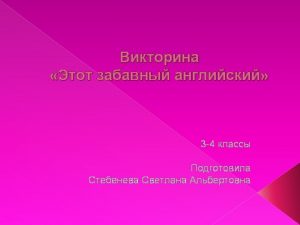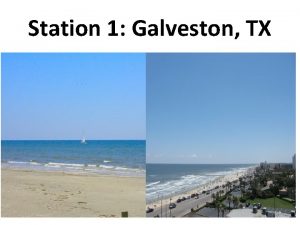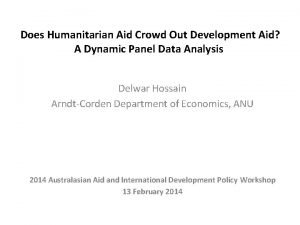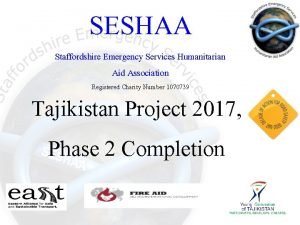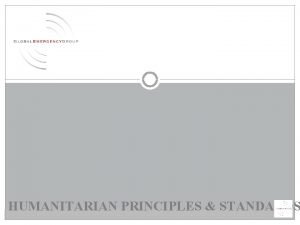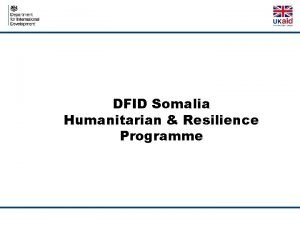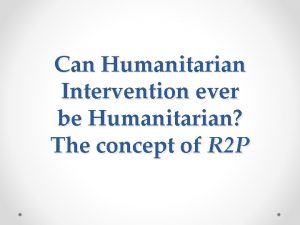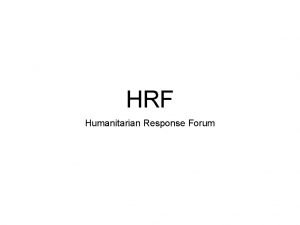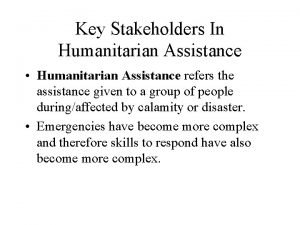Thirst Aid Station for emergency humanitarian relief Mechanically
























- Slides: 24

Thirst Aid Station for emergency humanitarian relief Mechanically Advanced Disinfection All Rights reserved © 2017 BW Technologies Ltd exercises copyright over its information to make sure that it is used in accordance with the company’s principles. Extracts of BWT information can be used for private study or for educational purposes without permission. Wider use requires permission to be obtained from BWT. The provision of a link to other sites does not indicate endorsement of those sites , and BWT accepts no responsibility for the validity or accuracy of their content. 1

What is a Thirst Aid Station? An emergency water purification system for immediate humanitarian response All Rights reserved © 2017 BW Technologies Ltd

Components Armour-weave 10 litre reservoir with in-built pre-filter Hose In. Line M. A. D. ® Purifier Thumb-switch All Rights reserved © 2017 BW Technologies Ltd Pure. Link connector

Packaging Complete ready-to-use system supplied in sealed durable packaging All Rights reserved © 2017 BW Technologies Ltd

Specifications Weight of TAS system complete (incl. packaging): <300 g Dimensions of system in packaging: <40 x 30 x 7 cm Capacity of Armour-weave reservoir: 10 litres Weight of In. Line M. A. D. ® Purifier (dry, excl. Pure. Link connectors): 75 g Dimensions of In. Line M. A. D. ® Purifier (excl. Pure. Link connectors): 119. 8 mm (L) x 52 mm (Dia. ) Purification capacity of In. Line M. A. D. ® Purifier: 1, 000 litres Flow rate: >1 litre/min Fail safe: The In. Line M. A. D. ® Purifier automatically ceases to permit water flow at the point of expiry (as long as water comes through, it is safe to drink). Shelf-life: 3 years All Rights reserved © 2017 BW Technologies Ltd

Operation Designed to be operated by recipients with minimal or no instruction All Rights reserved © 2017 BW Technologies Ltd

Additional marking The user instruction pictograms are also printed onto the reservoir. Additional marking can be permanently printed onto two faces of the purifier. All Rights reserved © 2017 BW Technologies Ltd

M. A. D. ® - how it works The MAD® purification media can be summarised as an augmented tortuous particle path depth filter. It is comprised of a three layer laminate. The MAD® core contains up to 400 layers of pores between high surface area (>500 m 2/g), sub -micron, charged nano-alumina fibres, Powdered Activated Carbon (PAC) and antimicrobial silver impregnated zeolites. The void space (mean size 1. 25 microns) allows higher water flow rates and a lower pressure drop of <0. 1 bar. There is no need to create the pressure required by ultrafiltration (UF) based products. The fibres create a natural electropositive charge (measured as penetrating into the surrounding water for up to 300 microns) which covers the entire depth and void volume between the fibres, and remove negatively charged sub-micron particles, e. g. viruses (attracted by what we call electrohesion) through electro-adsorption. Larger particles, e. g. bacteria and parasitic protozoan pathogens are captured by electrohesion and mechanical action, with the restriction of pathogenic cysts by mechanical restraint within the fibre matrix. The small PAC particle size (mean size ~8 micron) produces a rapid reaction with chemical contaminants. No adhesives are used to retain the PAC (it is held in place by the electrohesion) meaning that there is a greater PAC surface area available for reaction. The silver impregnate in the ~2 micron zeolites is used to inactivate and inhibit growth of retained bacteria, and is only released by ion exchange allowing for controlled delivery. The MAD® media is configured in a professionally engineered casing to ensure its integrity is maintained in the toughest of environments. All Rights reserved © 2017 BW Technologies Ltd Mechanically Advanced Disinfection

Microbiological performance Protection includes • • Campylobacter jejuni - Campylobacteriosis Escherichia coli (E. coli) Helicobacter pylori Salmonella enterica – Non-typhoidal salmonellosis Salmonella enterica serotype Typhi - Typhoid & Paratyphoid Fever Shigella – Shigellosis Vibrio cholera – Cholera • • Hepatitis A Hepatitis E Norovirus Poliovirus - Poliomyelitis • • Cryptosporidium parvum - Cryptosporidiosis Cyclospora cayetanensis - Cyclosporiasis Giardia intestinalis - Giardiasis Entamoeba histolytica - Amebiasis • Intestinal worms All Rights reserved © 2017 BW Technologies Ltd Mechanically Advanced Disinfection

Microbiological testing Test results of Pure Hydration M. A. D. ® filters from the London School of Hygiene and Tropical Medicine Water Contaminant Tested Bacteria (E. coli) Virus (Poliovirus) Parasitic protozoa (simulant beads) Influent Water Concentration 1. 67× 106 CFU/ml 5. 00× 107 PFU/ml 1. 40× 104 per 500/ml Effluent Water Concentration No bacteria found 5. 00× 102 PFU/ml No beads found Reduction 99. 99997% 99. 999% 99. 993% These results demonstrate that Pure Hydration M. A. D. ® filters meet and exceed international standards for microbiological pathogen removal. US EPA WHO Tier 1 WHO Tier 2 WHO Tier 3* PH MAD®** Bacteria 6 log 10 99. 9999% 4 log 10 99. 99% 2 log 10 99. 0% ≥ 6. 52 log 10 ≥ 99. 99997 % Viruses 4 log 10 99. 99% 5 log 10 99. 999% 3 log 10 99. 9% 5 log 10 99. 999% Protozoa 3 log 10 99. 9% 4 log 10 99. 99% 2 log 10 99. 0% ≥ 4. 15 log 10 ≥ 99. 993% * 2 out of 3 Tier 2 results required. ** As tested by the London School of Hygiene and Tropical Medicine (copies of original results available on request). All Rights reserved © 2017 BW Technologies Ltd

Chemical performance Protection includes: Heavy metals e. g. arsenic, mercury, lead, etc. Pesticides Volatile Organic Chemicals Bad tastes and odours All Rights reserved © 2017 BW Technologies Ltd Mechanically Advanced Disinfection

Chemical testing – metals Testing to US NSF 42 and NSF 53 standards was conducted by an independent laboratory in the United States which is accredited in accordance with National Environmental Laboratory Accreditation Conference (NELAC) standards, and which is registered with the US Environmental Protection Agency (EPA). All Rights reserved © 2017 BW Technologies Ltd Metal Contaminant in Water Tested Influent Water Concentration in µg/L Antimony Arsenic (+3 and +5) Beryllium Bismuth Cadmium Chromium (+3 and +6) Copper Iron Lead Manganese Mercury Nickel Selenium Zinc 6. 1 50. 0 50. 1 302 3080 3060 150 1060 6. 1 104 102 110 Filter Module Effluent Concentration in µg/L <0. 5 2. 6 5. 2 101 4. 14 150 <0. 5 21. 1 % Reduction 99. 9+ 99. 1 99. 8 96. 7 97. 2 85. 8 99. 9+ 80. 8

Chemical testing - pesticides Pesticide Contaminant in Water Tested Influent Water Filter Module Effluent Concentration 4, 4’-DDD 4, 4’-DDE 4, 4’-DDT Alachlor Aldrin Alpha-BHC Ametryn Atraton Atrazine Beta-BHC Bromacil Carbofuran Chlordane Chlorneb Chlorobenzilate Chlorothalonil Chlorprophane Chlorpyrifos Cyanizene Delta-BHC Dichlorvos Dieldrin Diphenamid Disulfoton Endosulfan Sulfate Endrin Aldehide in µg/L 50. 1 50. 2 50. 1 40. 2 50. 8 50. 0 50. 2 10. 0 50. 9 51. 2 80. 2 40. 2 51. 0 49. 9 50. 2 50. 3 50. 1 50. 7 50. 2 50. 0 6. 0 50. 5 All Rights reserved © 2017 BW Technologies Ltd in µg/L <0. 1 <0. 1 <0. 1 % Reduc -tion 99. 9+ 99. 9+ 99. 9+ Pesticide Contaminant in Water Tested (cont. ) Influent Water Concentration in µg/L Endrin Ketone Endusulfan II Ethoprop Fenamiphos Fenarimol Fluoridone Gamma-BHC (Lindane) Glyphosate Heptachlor Epoxide Methoxychlor Molinate PCB’s Prometron Simazine Toxaphene 50. 0 49. 8 50. 3 50. 4 50. 2 50. 4 2. 0 80. 0 4. 0 120 50. 4 10. 1 50. 0 12. 0 15. 1 Filter Module Effluent % Reduc -tion Concentration in µg/L <0. 1 <0. 1 99. 9+ 99. 9+ …and Fluoride Contaminant in Water Tested Influent Water Concentration in µg/L Sodium Fluoride 8. 0 Filter Module Effluent % Reduc -tion Concentration in µg/L 0. 4 95. 0

Chemical testing - VOCs VOC Contaminant in Water Tested Influent Water Concentration in µg/L Filter Module Effluent Concentration in µg/L % Reduc -tion VOC Contaminant in Water Tested (cont. ) Influent Water Concentration in µg/L Filter Module Effluent Concentration in µg/L % Reduc -tion 1, 1, 1, 2 -Tetrachloroethane 1, 1, 1 -Trichloroethane 1, 1, 2, 2 -Tetrachloroethane 1, 1, 2 -Trichloroethane 1, 1 -Dichloroethene 1, 1 -Dichloropropene 1, 2, 3 -Trichlorobenzene 1, 2, 3 -Trichloropropane 1, 2, 4 -Trichlorobenzene 1, 2, 4 -Trimethylbenzene 1, 2 -Dichloroethane 1, 2 -Dichloropropane 1, 3, 5 -Trimethylbenzene 1, 3 -Dichloropropane 1, 4 -Dichlorobenzene 2, 2 -Dichloropropane 2 -Chlorotoluene 4 -Isopropyltoluene Benzene Bromobenzene Bromochloromethane Bromodichloromethane Bromoform Bromomethane Carbon Tetrachloride Chlorobenzene 79. 8 81. 2 81 150. 3 80. 2 81 81. 2 80. 1 80. 2 160. 1 80. 5 80. 3 80. 4 80. 3 80. 1 79. 1 40. 3 81. 1 80. 2 81. 4 80 80 80. 2 80. 1 81 79. 5 <0. 5 0. 81 <0. 5 0. 7 <0. 5 <0. 5 1. 03 <0. 5 <0. 5 99. 9+ 99. 1 99. 9+ 99. 9+ 98. 7 99. 9+ 99. 9+ Chlorodibromomethane Chloroform Chloromethane cis-1, 2 -Dichloroethene cis-1, 3 -Dichloropropene Dibromomethane Dichlorodifluoromethane Ethylbenzene Hexachlorobutadiene Isopropylbenzene Methylene Chloride MTBE m-Xylene Naphthalene n-Butylbenzene n-Propylbenzene o-Xylene sec-Butylbenzene Styrene tert-Butylbenzene Tetrachloroethene Toluene trans-1, 2 -Dichloroethene trans-1, 3 -Dichloropropene Trichloroethene Trichlorofluoromethane Vinyl chloride 80. 4 80. 2 80. 1 170. 1 50. 2 80. 1 80 82 44 80. 3 81. 2 81. 5 70. 1 80. 4 80. 2 70. 1 80. 3 80 80. 2 80. 1 80. 2 80. 5 81 180. 3 80. 1 80. 3 <0. 5 <0. 5 1. 04 1. 83 <0. 5 1. 4 <0. 5 <0. 5 99. 9+ 99. 9+ 98. 8 97. 8 99. 9+ 98. 3 99. 9+ 99. 9+ All Rights reserved © 2017 BW Technologies Ltd

Logistics The Thirst Aid Station has been specifically designed to address the logistical burden of emergency humanitarian aid requirements, and help ensure that immediate drinking water needs can be met with minimal transportation resources. One pallet of Thirst Aid Stations (with a floor space footprint of just 1 x 1. 2 m)… Lightweight and compact, 20 Thirst Aid Stations are typically supplied in cost effective commercial carton packaging (50 x 36 cm; gross weight approx. 6 kg). One pallet of 720 Thirst Aid Stations (36 cartons) could weigh as little as 216 kg (excl. pallet), but deliver the equivalent safe drinking water as 720 tonnes of bottled water. The Thirst Aid Station allows you to fly further, fly for longer, and deliver more. All Rights reserved © 2017 BW Technologies Ltd …could typically deliver up to 720, 000 litres of drinking water.

Logistics The Thirst Aid Station is highly resilient to critical delivery by impactive air drop in otherwise inaccessible humanitarian disaster zones. Flexibly configured for optimum transportation, bulk Thirst Aid Station deliveries can be easily broken down into easily distributable loads once on the ground. All Rights reserved © 2017 BW Technologies Ltd

SPHERE requirements In addressing Sphere* Minimum Survival Water Needs (2. 5 to 3 litres/day person) a single Thirst Aid Station could meet the needs of a family of five persons for between 66. 67 and 80 days. Although primarily designed to ensure that disaster victims are able to purify water sources for safe drinking, a single Thirst Aid Station would supply Sphere Total Basic Water Needs (7. 5 to 15 litres/day person) for a family of five persons for between approx. 2 to 3. 5 weeks. . When an extended period of drinking water provision is required (or anticipated) the supply of additional In. Line M. A. D. ® Purifiers will enable flexible response to variable circumstances. * http: //www. spherehandbook. org/en/water-supply-standard-1 -access-and-water-quantity/ All Rights reserved © 2017 BW Technologies Ltd

Proven in action Philippines, 2014 Thirst Aid Station in use in the Philippines in. Leyte, January 2014 following Typhoon Haiyan two months earlier All Rights reserved © 2017 BW Technologies Ltd

Proven in action Thirst Aid Station demonstration by recipient, DPRK, April 2015 All Rights reserved © 2017 BW Technologies Ltd

Proven in action Thirst Aid Station recipients in Aleppo, Syria, March 2016 All Rights reserved © 2017 BW Technologies Ltd

Proven in action Thirst Aid Station in use with recipients after the April 2016 earthquake in Ecuador All Rights reserved © 2017 BW Technologies Ltd

Proven in action Thirst Aid Station with a recipient in Haiti following the Hurricane Matthew disaster in October 2016. Where next? We don’t know where the next humanitarian disaster will occur, but we do know that organisations that have included the Thirst Aid Station in their planning will be ready to reduce the risk of disease and death from waterborne pathogens.

Protection of aid personnel Thirst Aid Stations can also provide safe drinking water for aid agency teams operating in primary relief zones. Alternatively, the aquapure traveller™ may be issued for individual drinking water purification. The APT supplies the same level of protection as the Thirst Aid Station against microbiological and chemical contaminants in drinking water, with a purification capacity of 350 litres per unit (replacement purifier/caps also available). Supplied as 12 per carton (38. 5 x 24. 5 cm; gross weight approx. 1. 5 kg) producing a total of 4, 200 litres of clean, safe drinking water. Or you could just ship out 8, 400 x 50 cl of bottled water instead.

Contact John Saunders Sales Manager – Humanitarian Assistan Pure Hydration Abbey Business Park, Monks Walk Farnham, Surrey, GU 9 8 HT, UK Tel: +44 (0)333 600 7000 E-mail: john. saunders@purehydration. co
 Volumetric thirst
Volumetric thirst Ebra new deal
Ebra new deal Mechanically inclined definition
Mechanically inclined definition Revolutionzied
Revolutionzied Modified diet
Modified diet What are sedimenta
What are sedimenta Dietary adjustments after a gastrectomy are influenced by
Dietary adjustments after a gastrectomy are influenced by Mechanically cleaned bar screen
Mechanically cleaned bar screen Mechanical perspective drawing
Mechanical perspective drawing Pa wc bureau
Pa wc bureau Emergency care first aid and disasters
Emergency care first aid and disasters Humanitarian work psychology
Humanitarian work psychology Aerospace education foundation badge
Aerospace education foundation badge Humanitarian projects in prague for youth
Humanitarian projects in prague for youth Ihl
Ihl Humanitarian engineers in cape york
Humanitarian engineers in cape york Humanitarian
Humanitarian Khalifa humanitarian foundation
Khalifa humanitarian foundation Humanitarian programme cycle 2021
Humanitarian programme cycle 2021 Ee.humanitarian response.info/x/vpdlixjf
Ee.humanitarian response.info/x/vpdlixjf International humanitarian law icrc
International humanitarian law icrc Domistan
Domistan Cadet humanitarian award
Cadet humanitarian award Humanitarian work psychology
Humanitarian work psychology International humanitarian law icrc
International humanitarian law icrc


